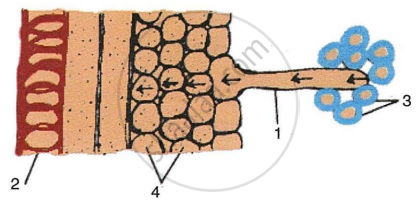Advertisements
Advertisements
Question
Deplasmolysis occurs when a plasmolysed cell is placed in ______.
Options
Concentrated salt solution
Tap water
Concentrated sugar solution
Hypertonic salt solution
Solution
Deplasmolysis occurs when a plasmolysed cell is placed in Tap water.
Explanation:
One hypotonic solution is tap water. Because the concentration of water outside the cell is higher, water moves within the cell. Subsequently, the cell expands and turns turgid. This is known as deplasmolysis.
APPEARS IN
RELATED QUESTIONS
Explain Turgor pressure
The diagram below represents a process in plants. The setup was placed in bright sunlight. Answer the following questions:

a) Name the physiological process depicted in the diagram.
Why was oil added to the water?
b) When placed in bright sunlight for four hours, what do you observe with regard to the initial and final weight of the plant? Give a suitable reason for your answer
c) What happens to the level of water when this setup is placed in:
- Humid conditions?
- Windy conditions?
d) Mention any three adaptations found in plants to overcome the process mentioned in (i).
e) Explain the term ‘Guttation’.
The state of a cell in which the cell wall is rigid and stretched by the increase in volume due to the absorption of water is called.
Differentiate between the following
Turgor pressure and Root pressure
Give Technical Term for the following.
A cell in a fully extended condition.
Name the following:
The process by which wilting or drooping of leaves occurs.
Name the following:
The condition in which the contents of a cell exert pressure against the cell wall making it distended.
Excessive use of fertilisers in agricultural fields reduces the yield of crops. Justify the statement.
When the cells of a plant are fully distended, the condition is called ______.
The figure given below is a diagrammatic representation of a part of the cross-section of the root in the root hair zone. Study the same and then answer the questions that follow:

- The parts labelled as 1, 2, 3 and 4 are:
- Root hair, Xylem vessel, Soil particles, Cortex respectively.
- Xylem vessel, Soil particles, Root hair, Cortex respectively.
- Root hair, Xylem vessel, Cortex, Soil particles respectively.
- Cortex, Soil particles, Xylem vessel, Root hair respectively.
- The process that enables the passage of water from soil into the root hair is:
- Diffusion
- Active transport
- Osmosis
- Passive absorption
- The kind of force which exists between a liquid and any surface is called as:
- Cohesive force
- Adhesive force
- Capillarity
- Suction force
- The kind of force between the same kind of liquid molecules is:
- Capillary force
- Transpirational pull
- Adhesive force
- Cohesive force
- Sometimes exudation of water occurs from the margin of the leaves in the early morning or night. It is termed as:
- Transpiration
- Guttation
- Bleeding
- Osmosis
